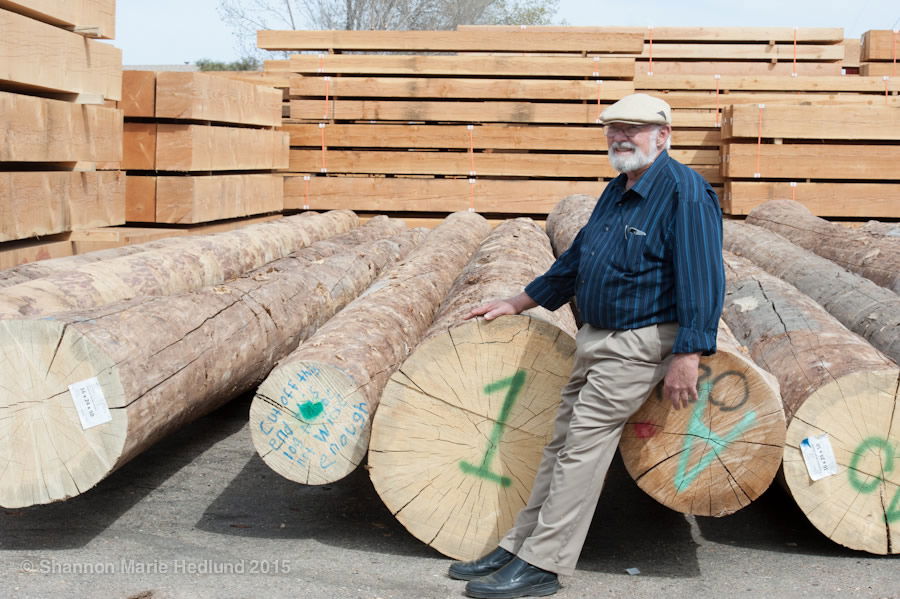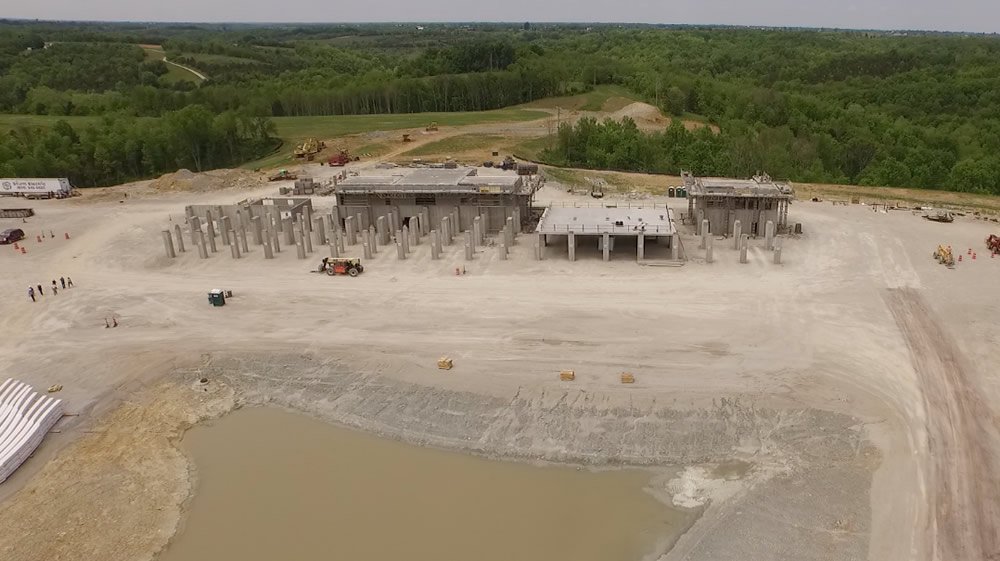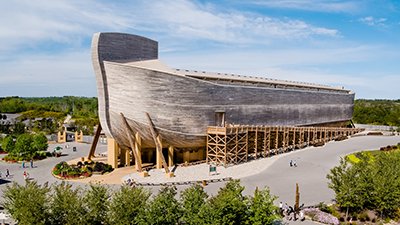Answering Claims About the Ark Project
As construction continues on the full-size Noah’s Ark, excitement and interest in the project continues to build from both Christians and non-Christians alike. Many people are wondering about the project in regard to its past construction in the days of Noah, compared to how we’re building the life-size Ark today. In this article we answer a number of the questions, criticisms, and other claims that we frequently hear via the Internet and social media places like Facebook. We will continue to update this article as questions and comments arise while construction continues on this project that will open sometime in 2016.
Many false claims we receive in regard to the construction of the Ark have come from non-Christians trying to denigrate the project. Just as we had scoffers attack the Creation Museum when it was under construction, today we also see many scoffers (even more this time) harshly criticizing and ridiculing the Ark Encounter project. Sadly, from my experience in responding to such scoffers, many do not care about hearing the truth about the project and aren’t really searching for answers. Nonetheless, for the sake of those who hear these skeptics, we do our best to give answers for those who will listen.
We also receive comments and questions from well-meaning Christians, many who have been unwittingly secularized on some topics related to Noah’s Ark and the Flood. Others simply have not thought through the account of the Ark from a biblical worldview perspective. And some Christians propagate false claims (often restating what some of the scoffers have claimed). I challenge such Christians to take heed of this verse: “He who answers a matter before he hears it, it is folly and shame to him
” (Proverbs 18:13).
Nonetheless, it’s been interesting to read many of the questions, comments, and articles by Christians and non-Christians pertaining to the construction of AiG’s life-size Noah’s Ark in Williamstown, Kentucky. So, let me deal with just some of these questions and claims to help people have a better understanding and appreciation of the project.
1. Claim: There is no way anyone could build a wooden ship the size of the Ark so it would actually float!
Based on an ancient cubit of 20.4 inches (please read this article about cubits to understand why we chose the one we did), the life-size Ark is 510 feet long, 85 feet wide, and 51 feet high. Actually, there are documents about ships in antiquity (since the Flood of Noah) that were this order of magnitude in size. I encourage you to read this article. In 1909, the wooden ship the Wyoming (450 feet from jib-boom tip to spanker boom tip) was launched, though it sank 15 years later. Also the Chinese and many other cultures are known to have built large wooden ships.

2. Claim: You shouldn’t be pouring all that concrete, as Noah didn’t use it.
Well, besides the fact that we really don’t know all that Noah did or didn’t do or use, Answers in Genesis is building this life-size Ark as a themed attraction that is estimated to see around two million visitors a year! To prepare for these visitors, we have to provide restrooms, food service, elevators, handicap accessibility, stairs, fire escape routes, and much more in the Ark. We have to comply with government building codes for such a public venue. To do this, and yet build a life-size Ark, our engineers and architects came up with a brilliant plan. We are building three towers, each 70 feet high (around seven stories) out of concrete and masonry blocks. These towers will house the elevators, stairs, restrooms, kitchen, 50,000-gallon water tank for fire suppression, and other infrastructure required for the public. The Ark will be anchored to these three towers as part of the engineering needed to handle wind load. In fact, the structure is being built to withstand forces far above code requirements.
Also, because we believe Noah would have elevated the Ark off the ground when he built it (as do modern ship builders), and because we want people to experience the size of the Ark, we have constructed 102 concrete piers on which to place the Ark. Actually, precast concrete slabs have already been laid on these piers, and more concrete has been poured on top of that. The wooden floor of the bottom deck will sit on these concrete slabs (that are required by code for fire protection) and the bottom of the Ark will be underneath the slabs—so no one will actually see the concrete slabs. The piers are each 15 feet high, but once the Ark is built, the bottom of the Ark will sit 12.5 feet off the ground.
3. Claim: With the number of trees you chopped down to build this wooden structure, you are helping destroy the environment.
Actually, many of the large timbers came from areas where a beetle infestation killed trees. Much of the remaining timber came from renewable forests, which are carefully managed. In fact, in America more trees are now being planted each year than those that are cut down. The total amount of timber (not counting for the Ark the exhibits) to be used in this wooden Ark is 3.3 million board feet. A board foot is a piece of wood 12 inches by 12 inches by 1 inch thick. In board feet, the amount of timber used would be 612 miles, equivalent to the distance between Williamstown, Kentucky (about 40 miles south of Cincinnati), and Philadelphia, Pennsylvania.


4. Claim: Those piers can’t really support the weight of the Ark.
At the Ark site, excavators removed 500,000 cubic yards of dirt to prepare for construction. The ground level was taken down about 30 feet, so it would be only four feet down to solid rock! The footings of each pier sit on this solid rock. I think it is very fitting that a Christian facility that proclaims God’s Word is being built on rock—the best solid foundation (Matthew 7:24–27)! And of course we also know that God is our rock or firm foundation (Psalm 18:2) with Christ being the chief cornerstone (Acts 4:10–12)!

5. Claim: You should only have one person building the Ark, as only one person, Noah, built it.
Actually, the Bible doesn’t say how many people built the Ark. We certainly read in Genesis 6 about Noah and his three sons and their wives. Lamech (Noah’s father) and Methuselah (Noah’s grandfather) could have helped for years prior to their deaths or other righteous people before they were murdered or died. But there is no record of many of the details of how the Ark was constructed. Just as we have done today to build the Ark, it is very possible Noah hired workers to help him construct the Ark (even though they may have scoffed at Noah as they worked). And we really don’t know how long Noah took to build the Ark. (For further information on this timeline point, read this article. Also read this article for more information on how many people may have been involved in the Ark’s construction.
6. Claim: The Bible doesn’t say the Ark looked like the one you are building. You have a shaped bow and stern, as well as a sail-like structure on the bow!
The Bible does not say the Ark must have been a rectangular box. In fact, Scripture does not discuss the shape of Noah’s Ark beyond those superb, overall proportions of length, breadth, and depth. Ships have long been described like this without implying a block-shaped hull—we still do this today! Also, we had engineers research ancient ships and perform water tank experiments, and they found that such structures on ancient ships had a dramatic effect on stability. For more information on the shape of the Ark, I encourage you to read this article.
Furthermore, Noah may have possessed a strong knowledge of shipbuilding before God called him to build the Ark, or he could have spent years acquiring such knowledge after God called him. Critics of the Bible’s history often assume that no one had built ships in Noah’s day, but nowhere does the Bible suggest this. As explained in more detail in the next response below, ancient man was highly intelligent. Even though we believe the pre-Flood world consisted of one large continent (derived from Genesis 1:9), people may have still used boats for shipping cargo and traveling.
7. Claim: But why are you using tools and cranes and other technology to build the Ark? Noah didn’t have such technology!
I’ve realized that even many Christians (most of them unwittingly) have adopted an evolutionary view of man’s intelligence and achievements over the millennia.
Many people today believe that ancient man slowly went from making “primitive” items (e.g., stone tools) to working with bronze and iron. But the evidence researchers have collected from around the globe refutes this false evolutionary view of human history. Humans have been highly intelligent from the beginning and could quickly gain knowledge to create sophisticated technology. For instance, we read the following about the descendants of Adam and Eve near the beginning of human history:
His brother’s name was Jubal. He was the father of all those who play the harp and flute. And as for Zillah, she also bore Tubal-Cain, an instructor of every craftsman in bronze and iron. (Genesis 4:21–22)
By the time of the Flood, who knows what technology people may have invented? The fantastic technology we enjoy today is the result of an accumulation of knowledge gained over the past few hundred years. Think how far technology has advanced in just 200 years! The beginnings of the technologies to build automobiles go back to the late seventeenth and early eighteenth centuries, and airplanes were invented just over 100 years ago. We can’t even imagine what many people might have invented by the time of Noah, about 4,400 years ago (approximately 1,600 years after Creation). Who knows what remarkable things were created by geniuses when Noah was building the great Ark? And with people living so long before the Flood, there would have been an incredible increase in knowledge. Imagine people like Alexander Graham Bell, Isaac Newton, Albert Einstein, and others living for hundreds of years and what they may have achieved! Check out these articles that deal with this fascinating subject.
It’s very possible that Noah had technology that would have astounded us (and we would have envied)! And for those scoffers who say that if Noah had such technology we would find evidence of it, they need to understand the sheer destructive processes of the global Flood. It essentially obliterated the pre-Flood world. Or as the Apostle Peter put it, “the world that then existed perished, being flood with water
” (2 Peter 3:6). Our geologist, Dr. Andrew Snelling, suggests much of the original continent was subducted into the mantle anyway. We have remnants of some of the pre-Flood life preserved in the fossil record, but the vast majority of these are sea creatures—which is expected since it was a marine catastrophe (Genesis 6:7)!
8. Claim: But you should be feeding the poor, not spending money on building an Ark.
There are multi-million dollar projects happening every day across America and around the world, yet the Ark project is singled out by critics in regard to their claims about the poor. The real reason people raise this objection has more to do with the message the Ark facility will proclaim than a humanitarian concern. I encourage you to read the article I wrote on this here. I also encourage you to read this article.
9. Claim: You should be spending money on spreading the gospel, not building an Ark.
Actually, we have made no apology about the fact that the Ark will present the truth of God’s Word and the gospel very boldly, yet graciously. We hope that no one will go away from the Ark Encounter without having heard the The Bad News . . . and the Good News. And how many Christian facilities are there in the world that would attract about two million visitors a year (including many non-Christians) where a clear presentation of the gospel is going to be presented.
The Ark structure will be the biggest timber frame building in the world, and thus it will be another reason to attract people from around the globe. What a phenomenal opportunity we will have to reach America and the world with the saving gospel message! The Ark project has already received worldwide media attention (as has the Creation Museum), and this will only increase over time. I encourage you to read this article on evangelism and the Ark.
10. Claim: There is no way the Ark will get the 1.4 million to 2.2 million visitors a year you claim will come.
Regardless of the naysayers, we stand by the professional primary source research conducted by America’s Research Group (ARG) that has predicted a minimum attendance in the first year of 1.4 million people and up to 2.2 million. This is the same group that predicted 400,000 visitors for the first year of the Creation Museum—and 404,000 came that year. I encourage you to read this article for more information. And as the saying goes, the “proof is in the pudding.” We will find out in 2017, as the Ark opens in 2016.

11. Claim: You shouldn’t be using government funds to build the Ark.
No government funding is being used to build the Ark. I think I need to state that again because it’s the false claim that’s been made the most, so let me state this fact again so that any readers will clearly understand: No government funding is being used to build the Ark. This is a false charge being spread largely by secularists opposed to the Ark project, and that object to a Christian facility being treated equally like any other organization for a sales tax rebate program. To find out all the details about this bogus claim, go to AnswersForFreedom.org. The life-size Ark project is being funded by a combination of a bond offerings, donations, and memberships. Find out more at ArkEncounter.com.
12. Claim: God is not with you on this project because it’s taken so long to build—longer than you originally stated.
Yes, it has taken longer than we originally thought. The same thing happened with the Creation Museum (in fact, it happens with many large-scale projects). First of all, from a Christian perspective we know that our timing is not necessarily God’s timing. “For my thoughts are not your thoughts, neither are your ways my ways, declares the Lord” (Isaiah 55:8; see also Psalm 75:2). The Bible makes it clear that God’s sovereignty goes hand in hand with man’s responsibility. From a human perspective, we have to deal with weather delays, permit applications (these are not easy to get in this day and age), and other construction-related issues that can cause delays. For instance, one of the many vital permits took nearly two years to obtain from the time we applied for it!
The funding and other issues are under God’s control—and we accept that. Scoffers may mock as they did in Nehemiah’s day (Nehemiah 4:1), but if God has called us to do something, it will happen. Maybe not exactly the way we thought or in the timing we envisaged, but if it is of God, then it will happen (Acts 5:39). The vision for the Creation Museum, which opened in 2007, goes back 35 years ago in Australia when one of our former board members and I prayed for a Creation Museum.
13. Claim: This Ark project is going to be a financial drain on Kentucky.
This is one of the most bizarre charges we have heard. Actually, the Ark Encounter will create several hundred jobs (directly and indirectly), and bring in hundreds of millions of tourism dollars (in fact, billions of dollars over 10 years) into Kentucky’s economy. Answers in Genesis hired outside consultants to research the economic impact of the Creation Museum over the past eight years and to estimate the future impact of the Ark Encounter. There’s no doubt the Creation Museum has already brought many millions of dollars into the state of the Kentucky. By a formula supplied to us by a tourism group, the museum adds about $60 million to the local economy each year with visitors staying at hotels, eating at local restaurants, and so on. The Ark Encounter will take this to a much higher level.
14. Claim: You are charging an admission fee to visit the Ark to make a lot of money.
Any major facility costs a lot of money not only to build, but also to maintain and staff (Romans 4:4). Just the operating and maintenance costs alone for the Ark will be enormous. Also, much of the funding for this project has come from a bond offering that requires interest and capital payments back to those who invested. For the Ark’s parking area alone (which will handle around 4,000 vehicles), excavators had to move one million cubic yards of dirt. Just to blacktop that parking area will cost nearly $4 million. We have to charge a realistic fee to cover such operating costs and still pay for future expansion. But, the entrance fee will be nothing like that to get into Disney World, Universal Studios, or many other theme parks.
For more information on the Ark Encounter project, go to this link where many other questions people asked are answered.
Recommended Resources

Answers in Genesis is an apologetics ministry, dedicated to helping Christians defend their faith and proclaim the good news of Jesus Christ.
- Customer Service 800.778.3390
- © 2024 Answers in Genesis






